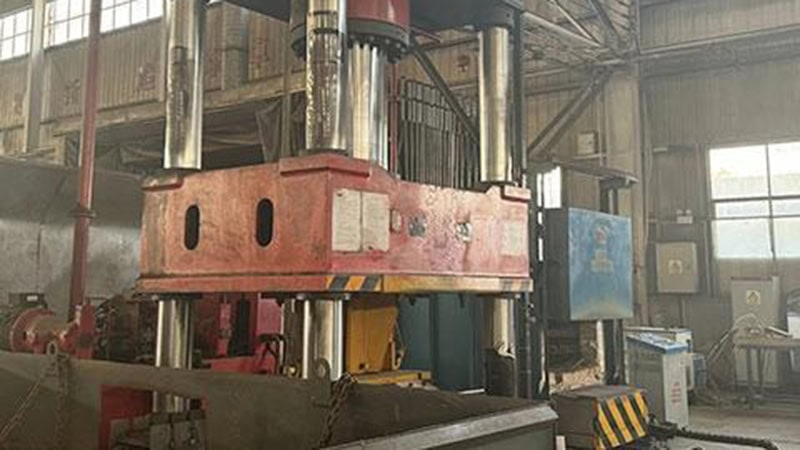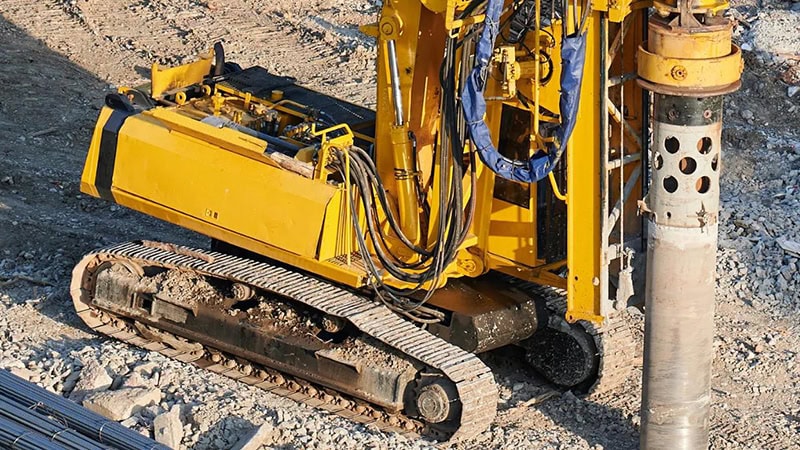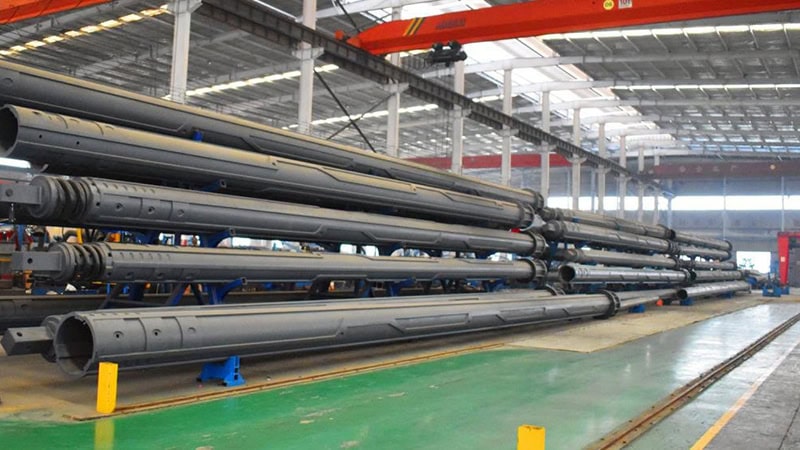
Key Takeaways:
- Friction Kelly bars provide reliable performance across a wide range of drilling depths, including deep foundation projects, due to their extendable multi-section design. They ensure consistent results on your projects by complying with strict origin and quality certifications.
- Their outer bar design ensures easier handling and smoother transitions between drilling sites, improving mobility and setup efficiency on your drilling tool.
- Telescopic Kelly bars integrate seamlessly with a drill rig, providing a safe and reliable performance.
- For higher torque or deeper boreholes, interlocking Kelly bars complement friction bars, providing added strength and stability where required.
Friction Kelly bars feature a simpler and versatile structural design compared to interlocking types, which can make handling and transport more manageable in specific configurations. They offer easier handling on rotary drilling rigs and adapt well to variable worksite conditions.
Their friction-based torque transmission provides advantages in certain soil types and project scenarios. At the same time, these Kelly bars are engineered by Everstar through superior materials and enhanced design to overcome challenges such as inefficiencies in certain soil conditions.
This article explores friction Kelly bar design, operational benefits, common drilling applications, maintenance practices, and rig compatibility. Everstar helps you select the right bar, providing guidance to ensure your drilling projects are reliable, efficient, and safe.
What Is a Friction Kelly Bar and How Does It Work?
Friction Kelly bars have a telescopic design where overlapping sections rely on contact between drive ribs and internal walls to transmit torque. They are commonly used on hydraulic rotary drilling rigs for specific soil and project needs.
Definition and Basic Function
A friction Kelly bar is made of overlapping telescopic sections, and torque is transmitted via drive keys and drive stub engagement, not by friction. Typical bars vary in section count and material, often using high-strength steel for durability and consistent performance in demanding drilling conditions.
How Torque Transmission Works in Friction Kelly Bars
Torque is transmitted through the drive keys integrated into the Kelly bar sections, allowing the bar to achieve maximum torque when properly maintained. Smooth contact and lubrication are critical, as neglect can reduce penetration rates and affect the reliability of your drilling tools.
Key Benefits of Friction Kelly Bars

The main advantages of this Kelly bar type include easier handling and cost-effective maintenance. They are also well-suited for soft to medium soils but less effective in dense or abrasive conditions.
Many friction bars incorporate a damping noise system, which minimizes vibration and improves operator comfort during long shifts on hydraulic rotary drilling rigs.
Design for Operational Versatility
Friction Kelly Bars are valued for their streamlined design and adaptability, making them suitable for a wide range of drilling applications. Their smooth operation and cost-efficiency make them especially advantageous for projects requiring moderate to deep drilling, depending on site conditions and rig capabilities.
Adaptability in Moderate Drilling Conditions
These bars excel in soft to medium-density soils, adapting smoothly to different soil layers and changing borehole conditions. Their versatile design supports projects with moderate depths, improving overall drilling performance.
Cost and Maintenance Advantages
Friction Kelly bars offer lower upfront costs and simpler maintenance routines than interlocking bars. The reduced mass minimizes wear on hydraulic rotary drilling rig components, while routine inspections and lubrication of the drilling tool are easy, lowering operational expenses.
Drilling Applications for Friction Kelly Bars

Well-suited for foundation piling in soft to medium soils, friction kelly bars provide reliable performance while drilling boreholes efficiently. Their design supports moderate torque requirements, and telescopic Kelly bars integrate seamlessly with your rotary drive tool for consistent results.
Foundation Piling in Soft to Medium Soils
These telescopic kelly bars are commonly used in residential, commercial, and light infrastructure projects. Their lightweight construction allows faster drilling cycles where torque demands are moderate, improving efficiency and reducing wear on the drilling rig during repetitive borehole operations.
Kelly Bar Drilling Rig Compatibility
Friction Kelly bars are compatible with most popular hydraulic rotary drilling rigs. They can be integrated with rotary drive tools, ensuring smooth operation and consistent results across different project types and drilling depths.
Limitations and Considerations

It is essential to understand the limits of friction Kelly bars regarding maximum drilling depth, torque, and soil conditions. Verify origin and quality certificates and ensure the chosen drilling method aligns with your project requirements.
Depth and Torque Capacity Limits
These bars are less suited for extreme drilling depths or very hard rock conditions. Applying excessive torque may cause slippage, impacting both your drilling tool efficiency and the precision of the borehole.
For industry standards and technical guidance on drilling equipment such as Kelly bars, refer to the International Association of Drilling Contractors (IADC) Technical Resources.
Soil and Weather Impact on Performance
Torque effectiveness decreases in wet or highly abrasive soils, making interlocking Kelly bars a suitable alternative. Regular cleaning, proper lubrication, and inspection are necessary to maintain consistent performance and extend service life.
Selecting the Right Friction Kelly Bar

Choosing the right friction kelly bar is essential for a smooth drilling process. Considering the inner and outer sections and your drilling equipment ensures compatibility, efficiency, and reliable performance throughout your project.
Matching Bar Specs to Rig Capacity
Check torque ratings, section lengths, and total weight to avoid overloading your rig. Proper sizing prevents operational issues and ensures the bar works efficiently with your drilling equipment. Avoid oversizing or undersizing relative to rig specifications.
Customization Options
Standard Kelly bars can be customized with adjustable section lengths, material grades, and protective coatings to suit specific soil conditions and project demands. Everstar can supply friction Kelly bars tailored to your project needs.
FAQs – Kelly Bar Drilling
What is the difference between a friction Kelly bar and an interlocking Kelly bar?
Friction Kelly bars’ torque is transmitted via mechanical engagement of drive keys; no mechanical locking occurs vertically. Interlocking Kelly bars use mechanical locks for higher torque, deep-hole stability, and precision, suited for harder soils and demanding drilling projects.
What are friction Kelly bars best used for?
They are ideal for soft to medium-density soils and moderate drilling depths. They offer a versatile design that supports easier handling and faster setup. While configurations vary, many models help reduce load on hydraulic rotary drilling rigs without compromising borehole accuracy.
How deep can a friction Kelly bar drill?
Friction Kelly bars can be engineered to handle moderate to deep drilling depths, including demanding foundation work, especially when configured with multiple high-strength sections. Modern friction Kelly bars, like those from Everstar, are built to minimize slippage and maintain efficient performance in a wide range of soil conditions.
Which rigs are compatible with friction Kelly bars?
Most rotary drilling rigs with small-to-medium torque are compatible. Friction Kelly bars integrate smoothly with rotary drive tools, ensuring consistent performance and precise drilling across multiple project types while supporting the rig’s operational limits.
How can I extend the service life of a friction Kelly bar?
Regular cleaning, proper lubrication, and routine inspection of the bar are essential. Ensuring correct torque application, monitoring wear on inner and outer sections, and following manufacturer guidance preserves performance and prevents damage during repeated drilling cycles.
Conclusion – Making the Most of Friction Kelly Bars on Site
A friction Kelly bar is a great option for operators looking for more simplicity and versatility in drilling solution. By understanding its strengths, limitations, and best-use scenarios, you can optimize drilling efficiency, reduce operational costs, and maintain consistent borehole accuracy across projects.
Enhance Your Drill Rig Efficiency Today
Looking for a reliable friction Kelly bar for your next project? Contact Everstar Machinery for expert guidance and access to a full range of durable, high-performance Kelly bars, customized for your rig setup and specific drilling application. Explore our complete catalogue today.